Abstract
In this paper, a dual-band conductive textile-based wearable antenna operating at LoRa-868 MHz and BLE-2.4 GHz is presented. The proposed antenna is intended for accurate geolocation, tracking and communication applications in the military, industrial and telemedicine industries. The low-profile patch antenna is suitable for integrating into clothing. It is composed of three textile layers: top and bottom silver-ink-printed polystyrene fabrics, and a neoprene substrate. To utilize the flexible and restorable properties of these textile materials, the proposed antenna is directly fed by a flexible cable using an aperture-coupled feeding technique. This method not only eliminates the use of the conventional, bulky, and metallic SMA connector but also introduces a secondary resonance at 2.4 GHz, enabling the dual-band property. Using a thin coaxial cable fixed on the aperture slot for proximity coupling, a compact antenna size of 150 mm2 is obtained that can easily be attached and detached on existing cloths. The proposed structure has been fabricated and measured in an anechoic chamber to verify the performance. Measured gain of 3.28 dBi and 3.25 dBi was realized for LoRa and BLE at an antenna size of 0.61 λg × 0.61 λg × 0.012 λg (where λg is guided wavelength at 868 MHz) with a front-to-back ratio (FBR) of greater than 10 dBi.
1. Introduction
Over the past two decades, the market for wearable electronics and sensors has experienced rapid growth, reaching 181.5 million wearable device units sold in 2019 with forecasts predicting 520.1 million units sold by 2025 [1]. It is also expected that an antenna device will evolve to become “truly wearable”, implying that it will be attached/implanted on or into the human body or clothing. The latter, also known as “smart clothing”, is currently gaining attention as it is non-invasive to the human body and is feasible for various non-biomedical applications, such as safety, fashion, sports and the military.
Several state-of-the-art clothing-integrated wearable sensors have been developed and commercialized for strain or vital-sign sensing applications [2,3,4,5,6,7,8,9,10,11,12,13,14,15,16]. They are made with conductive textiles (or threads) with limited conductivity from 104–106 S/m with the capability to deliver direct current (DC) or low-frequency electric current (up to a few hundreds of kHz) without changing the operating frequency of the intended application [2]. The data acquired by these sensors should be wirelessly transferred to an external device (e.g., a cell phone, Wi-Fi router or repeater). To realize this, an antenna is needed to transmit or receive electromagnetic waves. The antenna is the most challenging component to embed in clothing, as it harnesses and radiates high-frequency electromagnetic fields.
For instance, the operating frequency bands of popular Internet-of-things (IoT) communication devices such as the long-range wireless access network (LoRaWAN) and the Bluetooth low energy (BLE) network are 870 MHz and 2.4 GHz, respectively, which are several orders of magnitude higher than the frequency used for the aforementioned wearable sensors. At these high frequencies, resistive losses due to the finite conductivity of the conductive textiles are significant, degrading the radiation efficiency (er) of a textile-based antenna. These degradations are primarily corrected by modifying the antenna geometry such as radiator size and thickness. Furthermore, this results in a relatively larger antenna, making it challenging to embed into clothing. The other approach to solve the finite degradation is to use semiflexible substrates and copper sheets which offer better performance compared with textiles. Rogers RT/Duriod 5880 substrate is used in [10] to achieve a semi-bendable dual-band antenna at 2.45 GHz and 5.85 GHz. In [13], they used copper sheets on a denim jeans fabric substrate. However, they do not truly achieve wearable flexibility and durability due to their semi-rigid substrates and peelable radiators.
Another issue facing wearable antenna technologies is the high-frequency connector used to feed the antennas. It is impractical to use a bulky rigid metallic connector on clothing even when the wearable antenna and cable are made of fully flexible materials. Various textile-based wearable antennas have been studied and reported [3,4,5,6,7,8,9,10,11,12,13,14,15,16], but most of them use a bulky subminiature version A (SMA) connector, which is acceptable for prototype measurements but inappropriate for commercialization.
The dual-band antenna in [9] was designed with a ShieldIt conductive textile and operated at 2.44 GHz and 5.0 GHz. The proposed antenna had excellent bending and radiation performance but could not operate at lower frequencies without increasing the size of the complex radiator structure attached directly to an SMA connector. Similarly, the dual-band antennas proposed in [10,13,14,15] focused on miniaturization techniques with modified patch radiator geometries operating at ISM (industrial, scientific, and medical) bands of 2.48 GHz and 5.8 GHz ISM band range. The inherent drawback in these designs is the limitations caused by directly connecting the radiator patch to the SMA connector. The connection is made either directly onto the radiator plate [10] or using the probe-fed technique [9,13,14,15]. The former, among other disadvantages, limits the design structure to maintain accurate impedance matching with the connector. The probe-feeding technique also limits the operating bandwidth due to the dissimilar substrate property interactions of the Teflon (in SMA) and fabric spacers. Consequently, these designs are not able to achieve lower frequency impedance performance without increasing the radiator and ground sizes significantly and also pose connection challenges when worn on the body. Table 1 shows the comparison made with previous studies that show the dimension of the antenna together with the common feeding methods used for wearable antennas.

Table 1.
Comparison of Dual-Band Wearable Antennas.
In this paper, we propose an all-textile dual-band wearable antenna suitable for embedding onto clothing. “All-textile” literally means that the antenna radiator, ground and substrate are composed of textile materials. More specifically, a flexible and restorable neoprene substrate [17] is sandwiched between the conductive-ink-printed polystyrene fabrics, as shown in Figure 1a. The inset photo also shows the integration mechanism onto existing non-conductive clothing. The antenna can be attached using velcro-based fasteners or removable elastic adhesives and resin. This increases the versatility of the proposed antenna as it can be attached and detached easily. The proposed antenna operates at two distinct frequencies: the 868 MHz LoRa and the 2.4 GHz BLE bands. Both frequency bands are the popular IoT communication protocols for long-range (several kilometres) and short-range (a few tens of meters) communications [18].
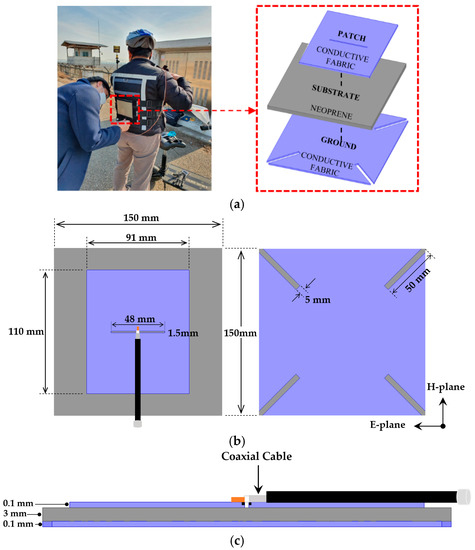
Figure 1.
Geometry of proposed wearable antenna with cable placement (a) left: textile antenna embed on vest/right: perspective view; (b) top and bottom view; (c) side view.
As far as we had covered during the literature study, no reference was found for a textile antenna simultaneously operating at LoRa 868 MHz and BLE 2.4 GHz. Furthermore, the proposed antenna eliminates the use of bulky metallic connectors by feeding directly a slot on the ground by a cable and then exciting the radiator by aperture coupling. A prototype of the proposed antenna was fabricated and tested in an antenna measurement chamber. The results showed that the antenna radiates broadside with reasonable antenna gains (>3 dB) and a low back-lobe (<−10 dB) for both the 868 MHz LoRa and the 2.4 GHz BLE bands.
2. Antenna Design
The design of the dual-band antenna was carried out by carefully optimizing the dimensions of the patches and slots in the antenna using a 3D full-wave electromagnetic simulator (ANSYS HFSS) [19].
2.1. Materials
The conductive fabric used for the patch and the ground is a silver-ink screen-printed polyester fabric. The silver ink (Henkel Acheson Electrodag 479SS) has sheet resistivity of 0.02 Ω/sq/mil, which corresponds to bulk conductivity of 1.97 × 106 S/m [20]. The conductive fabrics, in this case, the silver-ink screen-printed polyester fabric, for the top patch and bottom ground were developed in partnership with the Korea Textile Development Institute (KTDI) and the Korea Institute of Industrial Technology (KITECH). Before the screen-printing of the silver ink, the polyester fabric went through tendering, scouring and calendaring processes to eliminate impurities and to reduce the surface roughness. Much of the fabric considerations and its preparation have been reported in our previous works [4,16]. The antenna substrate is neoprene which is a blend of synthetic rubbers and textiles. The synthetic rubber content of neoprene also acts as an insulation between the radiating section of the antenna and the human body, thus minimizing the human body effect on the antenna performance. Furthermore, it exhibits excellent mechanical properties such as stretchability and resistance to mechanical stress. The relative permittivity (εr) and loss tangent (tan δ) of neoprene are 1.95 and 0.02, respectively, which are similar to felt, a popular substrate candidate for textile-based antennas.
2.2. Design Structure
The antenna was excited at the centre of the slot using the well-known aperture-coupled patch antenna technique [21,22]. This is beneficial for the proposed textile-based antenna given that there is no need to penetrate the flexible neoprene substrate using a metallic pin for excitation. Traditional aperture-coupled antennas are fed by a slot at the bottom ground with an additional feeding layer [21,22]. In contrast, the proposed design is fed by placing the cable on the radiating patch, which reduces the backward radiation and promote better tunability of dual-band resonances. The induced electromagnetic fields at the slot are bounced back by the ground and then radiated toward the boresight. In addition, the proposed design does not require an additional feeding layer because the slot is directly fed by a coaxial cable.
The dual-frequency performance is introduced by optimizing the sizes of the patch and the slot, for the lower 868 MHz and higher 2.4 GHz bands, respectively. Based on the simulations, the optimal antenna dimensions for the radiating patch were found to be 110 mm × 91 mm on a 150 mm square ground. More specifically, the longer side of the patch, which is vertical to the excitation slot, has an approximate half-wavelength of 868 MHz, λg (868 MHz)/2 ≈ 110 mm, and the length of the slot is close to a half-wavelength of 2.4 GHz, λg (2.4 GHz)/2 ≈ 48 mm. As the 2.4 GHz resonance is dependent on the relative position of the middle slot and width of the patch, the optimized size of the radiator is much smaller compared with the ground size needed for the 868 MHz resonance.
Figure 2 shows the simulated surface current density on the top patch at 2.4 GHz. As shown in the figure, strong currents excited in the middle slot are also induced onto the top and bottom edges of the patch. This secondary resonance at 2.4 GHz can be controlled by the slot length or the patch width. Figure 3 shows the reflection coefficient (S11) when varying the patch width from 90 mm to 96 mm. It is interesting to note also that the patch width alters the resonant frequency of the high band (2.4 GHz) but not the low band (886 MHz). This occurs because the low band resonance is mainly controlled by the patch length.

Figure 2.
Simulated surface current density on the antenna’s radiating patch at 2.4 GHz.
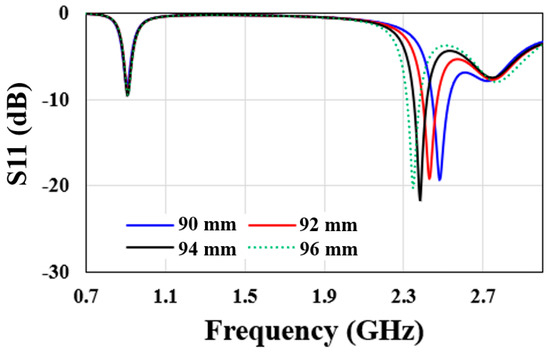
Figure 3.
Simulated antenna’s reflection coefficient (S11) when varying the patch width.
2.3. Backlobe Reduction Technique
A drawback of employing the aperture-coupled feeding method is an increase in high-frequency back radiation [23]. The fringing fields generated by the strong slot currents diffract at the edges of the ground, resulting in a non-negligible amount of back radiation, decreasing the antenna’s front-to-back ratio (FBR). To reduce this issue, four diagonal slots are implemented in the ground, as shown in Figure 1b. These quarter-wavelength-long slots effectively choke the current induced at the ground edges [24]. Thus, the back radiation is not only reduced but also tends to improve the forward radiating (i.e., main lobe) gain. Figure 4a shows the simulated surface current distribution on the ground plane at 2.4 GHz. As depicted, strong currents are concentrated at the inner edge of the diagonal slots, while only a weak current level is observed at the beginning of the slots. That is, the high-impedance open circuit effectively chokes the ground edge currents, while the inner short circuit with low impedance attracts the currents and then redirects them to the front patch, increasing the forward radiation. Figure 4b compares the simulated E-plane radiation patterns with and without this diagonal choking at 2.4 GHz. A reduction and improvement of the back and front radiation can be observed, respectively, when employing this strategy. As a result, the FBR and peak gain of the antenna are improved by 8.3 dB and 2.04 dB, respectively.
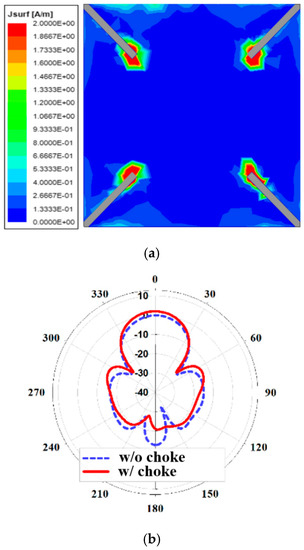
Figure 4.
Effects of introducing diagonal choke points in the antenna ground: (a) simulated surface current density on the ground; (b) simulated E-plane radiation pattern with and without the choke.
3. Antenna Fabrication and Measurement
3.1. Antenna Fabrication
Having optimized the antenna geometry using a full-wave simulation tool, we then fabricated prototype samples.
The prepared conductive fabric and neoprene substrate were then tailored to precise dimensions using a sub-millimetre accurate textile cutting tool (Cricut Maker®). Double-sided adhesive tape was used to attach the conductive fabrics onto the neoprene substrate. They were pressed and heated to ensure secure bonding. It should be noted that the final dimensions of pre-cut fabrics were slightly larger to give room for cutting errors. This was dependent on the cutting machine used which had an error margin of ±0.5 mm for neoprene and ±0.1 for the conductive fabric. The adhesive film may have influenced the initial trials of the prototype and may have been corrected by incorporating its performance shifts in the simulation model of the conducting fabric. The proper adjustments were thus made to accommodate these errors after several prototype trials. Figure 5 shows the fabricated antenna with a zoomed-in picture of the antenna feed. The inner conductor of the coaxial cable is attached to the upper section of the aperture slot using conductive epoxy. Similarly, the outer conductor is attached below the slot, emulating a line source across the slot. It is important to note that the conductive epoxy required about 24 h to be fully cured. For best practices, a non-conductive thread was used to clasp the inner conductor across the slot. The fabricated antenna including the feed cable weighs 98 g. Aside from the proprietary printed fabrics [16], all other materials used such as neoprene, conductive epoxy, and coaxial cable are commercially available and can be inexpensively obtained.
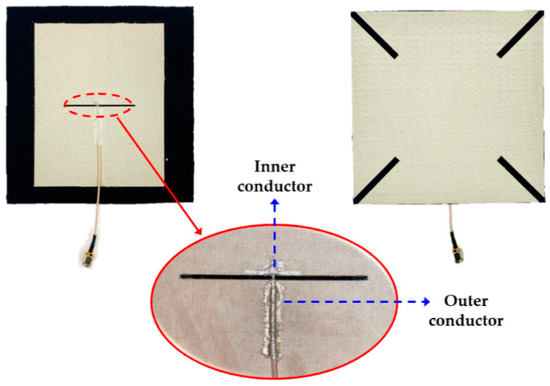
Figure 5.
Top and bottom view of the fabricated antenna (inset is a zoomed-in photo of the feeding area).
3.2. Antenna Measurement and Discussion
The S11 of the fabricated antenna was measured using a vector network analyzer (Anritsu MS2038C). Figure 6 shows the S11 result for the simulated and measured antenna model. The measured results are shown for when the antenna is integrated into a jacket (on-body) and when it is not (off-body). Figure 1a shows the on-body measurement scenario. As can be observed, there is good agreement between the simulated and measured results. The off-body measured S11 is on average 1.5 dB lower than the simulated value due to material losses and possible fabrication errors. The off-body measured S11 < −10 dB bandwidth is 32 MHz (854–886 MHz) for the lower band and 250 MHz (2.4–2.65 GHz) for the higher band, broad enough to cover the LoRa and BLE frequency spectrums, respectively. The on-body S11 < −10 dB was observed at 825–868 (43 MHz) and 2.37–2.6 GHz (230 MHz) for LoRa and BLE respectively. The on-body measurement shows a slight shift in the frequency at both bands with a 20 MHz reduction in the bandwidth at BLE. Although this may be due to the interference of the body on the antenna, the results remain largely unchanged as the antenna operates within the LoRa (863–870 MHz) and BLE (2.40–2.48 GHz) bandwidths. In addition, the position of the aperture feeding section, which is a source of interference for most wearable antennas, was placed far from the body and may have been an advantage in ensuring minimal body interference.
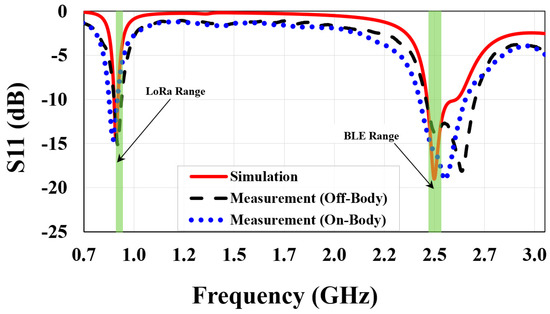
Figure 6.
Measured antenna’s S11 compared to the simulated result.
The fabricated antenna was placed in an anechoic chamber to measure its radiation performance. Figure 7 shows a picture of the antenna mounted on a mast and connected to a test cable, ready for measurement. Figure 8 and Figure 9 are the measured E- and H-plane radiation patterns at 868 MHz and 2.44 GHz, respectively. The measured and simulated H-plane patterns are similar to each other, while the E-plane patterns show deviations such as unexpected nulls and lobes. These are caused by the test cable exposed along the E-plane scan direction (i.e., the horizontal axis in Figure 1b). The in-and out-of-phase additions of the antenna-radiated waves and the test-cable-reflected waves provide these irregular patterns. Nonetheless, the overall envelopes show correlations with respect to their gain and half-power beamwidths (HPBW). The peak gains of 3.28 dBi and 3.35 dBi at the boresight are recorded for 868 MHz and 2.44 GHz with corresponding FBR outcomes of 10.12 dB and 18.13 dB. The HPBW are 81° and 40° for 868 MHz and 2.44 GHz, respectively.
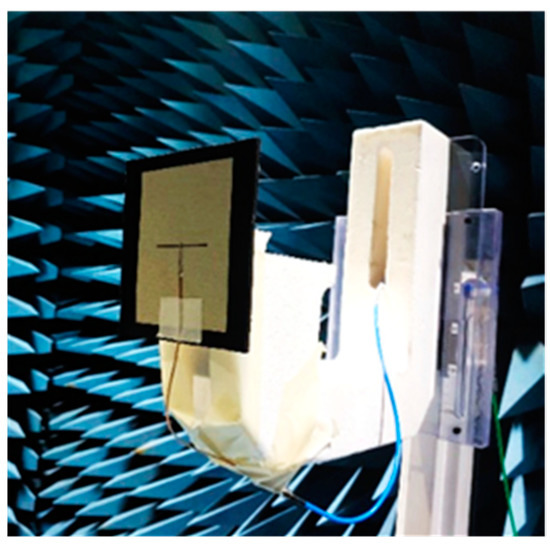
Figure 7.
Antenna prototype mounted in an anechoic chamber.
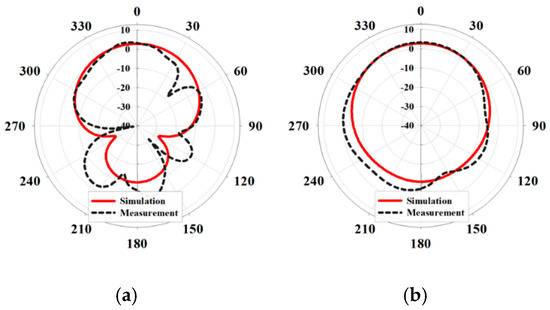
Figure 8.
Measured and simulated antenna radiation patterns at 868 MHz: (a) E-plane; (b) H-plane.
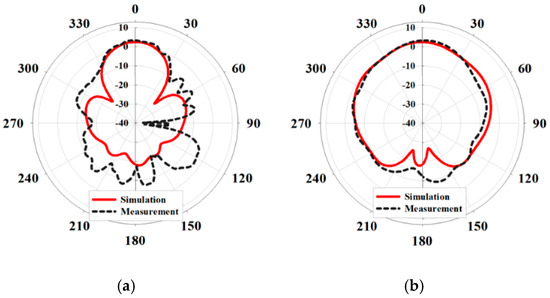
Figure 9.
Measured and simulated antenna radiation patterns at 2.44 GHz: (a) E-plane; (b) H-plane.
Table 2 summarizes and compares the electrical size, operation frequency, gain and FBR of several notable dual-band wearable antennas to the proposed antenna. The antenna’s electrical size is normalized by the guided wavelength (λg) at the lowest operating frequency. The antenna feeding methods and substrate materials of the other antennas are also listed. All of them, except for the proposed antenna, are directly probed by a bulky SMA connector (SMA-C) either mounted at the side or bottom of the substrate. This would limit the feasibility of utilizing lightweight, flexible and stretchable substrates. The proposed antenna is implemented on a flexible neoprene substrate and directly fed by a coaxial cable using the aperture-coupling technique, making it more feasible as a wearable antenna compared to the other candidates. The volume (length × width × height), gain and FBR are also comparable to the other references as shown in Table 1 and Table 2; although the operating frequency is lower for the proposed antenna.

Table 2.
Comparison of Dual-Band Wearable Antennas.
4. Conclusions
A compact and low-profile wearable antenna is presented. The proposed antenna feeding technique induces dual-band resonances at 868 MHz and 2.44 GHz for LoRa and BLE wireless communication. In addition, it eases the integration of wearable antennas into everyday clothing seamlessly without the discomfort of metallic connectors. The fabricated prototype was measured in an anechoic chamber and the results show the antenna gain better than 3 dBi and FBR better than 10 dB at both frequency bands. The measured S11 < −10 dB impedance bandwidths are 854–886 MHz and 2.4–2.65 GHz, respectively. S11 measurements have also been shown for when the antenna is integrated into clothing with negligible performance degradation. The H-plane radiation patterns are conformal to the simulation results while the E-plane radiation patterns have some discrepancies. This may be due to the coaxial cable placement along the E-plane axis which can be improved by using a more shielded cable, offering less interference.
Author Contributions
Conceptualization, J.-Y.C. and H.K.; methodology, J.-Y.C. and P.A.D.; simulation, N.F.I.; experiment, N.F.I. and P.A.D.; writing—original draft preparation, N.F.I. and P.A.D.; writing—review and editing, J.-Y.C. and H.K. All authors have read and agreed to the published version of the manuscript.
Funding
This work was supported by the Seoul National University of Science and Technology (SeoulTech) through the Advanced Research Project.
Conflicts of Interest
The authors declare no conflict of interest.
References
- GlobeNewswire: Research & Markets. Available online: https://www.globenewswire.com/ (accessed on 5 January 2021).
- Yilmaz, E.; Kasilingam, D.P.; Notaros, B.M. Performance analysis of wearable microstrip antennas with low-conductivity materials. In Proceedings of the 2008 IEEE Antennas and Propagation Society International Symposium, San Diego, CA, USA, 5–12 July 2008. [Google Scholar]
- Loss, C.; Goncalves, R.; Lopes, C.; Pinho, P.; Salvado, R. Smart Coat with a Fully-Embedded Textile Antenna for IoT Applications. Sensors 2016, 16, 938. [Google Scholar] [CrossRef] [PubMed]
- Aprilliyani, R.; Dzagbletey, P.A.; Lee, J.H.; Jang, M.J.; So, J.-H.; Chung, J.-Y. Effects of Textile Weaving and Finishing Processes on Textile-Based Wearable Patch Antennas. IEEE Access 2020, 8, 63295–63301. [Google Scholar] [CrossRef]
- Chin, K.-S.; Wu, C.-S.; Shen, C.-L.; Tsai, K.-C. Designs of Textile Antenna Arrays for Smart Clothing Applications. Autex Res. J. 2018, 18, 295–307. [Google Scholar] [CrossRef] [Green Version]
- Chahat, N.; Zhadobov, M.; Coq, L.L.; Sauleau, R. Wearable Endfire Textile Antenna for On-Body Communications at 60 GHz. IEEE Antennas Wirel. Propag. Lett. 2012, 11, 799–802. [Google Scholar] [CrossRef]
- Potey, P.M.; Tuckley, K. Design of wearable textile antenna for low back radiation. J. Electromagn. Waves Appl. 2019, 34, 235–245. [Google Scholar] [CrossRef]
- Torre, P.V.; Agneessens, S.; Verhaevert, J.; Rogier, H. Body-worn channel characterization unit for the 868 MHz band. In Proceedings of the 12th European Conference on Antennas and Propagation (EuCAP 2018), London, UK, 9–13 April 2018; pp. 1–5. [Google Scholar]
- Rais, N.H.M.; Soh, P.J.; Malek, M.F.A.; Vandenbosch, G.A. Dual-Band Suspended-Plate Wearable. IEEE Antennas Wirel. Propag. Lett. 2013, 12, 583–586. [Google Scholar] [CrossRef]
- Le, T.T.; Yun, T.-Y. Miniaturization of a Dual-Band Wearable Antenna for WBAN Applications. IEEE Antennas Wirel. Propag. Lett. 2020, 19, 1452–1456. [Google Scholar] [CrossRef]
- Simorangkir, R.B.V.B.; Yang, Y.; Matekovits, L.; Esselle, K.P. Dual-Band Dual-Mode Textile Antenna on PDMS. IEEE Antennas Wirel. Propag. Lett. 2017, 16, 677–680. [Google Scholar] [CrossRef]
- Bhattacharjee, S.; Maity, S.; Chaudhuri, S.R.B.; Mitra, M. A Compact Dual-Band Dual-Polarized Omnidirectional Antenna for On-Body Applications. IEEE Trans. Antennas Propag. 2019, 67, 5044–5053. [Google Scholar] [CrossRef]
- Wang, K.; Li, J. Jeans Textile Antenna for Smart Wearable Antenna. In Proceedings of the 2018 12th International Symposium on Antennas, Propagation and EM Theory (ISAPE), Hangzhou, China, 3–6 December 2018; pp. 1–3. [Google Scholar]
- Yan, S.; Soh, P.J.; Vandenbosch, G.A.E. Wearable Dual-Band Magneto-Electric Dipole Antenna. IEEE Trans. Antennas Propag. 2015, 63, 4165–4169. [Google Scholar] [CrossRef]
- Yan, S.; Soh, P.J.; Vandenbosch, G.A.E. Low-Profile Dual-Band Textile Antenna with Artificial Magnetic Conductor. IEEE Trans. Antennas Propag. 2014, 62, 6487–6490. [Google Scholar] [CrossRef]
- Lee, J.H.; Dzagbletey, P.A.; Jang, M.; Chung, J.-Y.; So, J.-H. Flat Yarn Fabric Substrates for Screen-Printed Conductive Textiles. Adv. Eng. Mater. 2020, 22, 2000722. [Google Scholar] [CrossRef]
- Hoagland, H.; Morrow, B. Using rainwear as switching jackets: A reasonable solution for electric arc exposure. IEEE Trans. Ind. Appl. 2000, 36, 1241–1246. [Google Scholar] [CrossRef]
- Antenna and Accessories for Wireless Network. Available online: https://interline.pl/Information-and-Tips/LONG-RANGE-IOT (accessed on 10 May 2021).
- Ansys Inc. Ansys HFSS; Ansys Inc.: Canonsburg, PA, USA, 2021. [Google Scholar]
- Henkel-Adhesive Technologies Loctite Edag 479SS E&C: Technical Datasheet. Available online: https://www.henkel-adhesives.com/kr/en/product/inks-_-coatings/loctite_edag_479ssec.html (accessed on 21 January 2021).
- Kong, D.K.; Kim, J.; Woo, D.; Yoon, Y.J. Broadband Modified Proximity Coupled Patch Antenna with Cavity-Backed Configuration. J. Electromagn. Eng. Sci. 2021, 21, 8–14. [Google Scholar] [CrossRef]
- Ali, A.; Wang, H.; Yun, Y.; Lee, J.; Park, I. Compact Slot Antenna Integrated with a Photovoltaic Cell. J. Electromagn. Eng. Sci. 2020, 20, 248–253. [Google Scholar] [CrossRef]
- Balanis, C.A. Antenna Theory: Analysis and Design, 4th ed.; John Wiley & Sons, Inc.: Hoboken, NJ, USA, 2016. [Google Scholar]
- Lim, W.-G.; Jang, H.S.; Yu, J.W. New method for back lobe suppression of microstrip patch antenna for GPS. In Proceedings of the 40th European Microwave Conference, Paris, France, 28–30 September 20. [CrossRef]
Publisher’s Note: MDPI stays neutral with regard to jurisdictional claims in published maps and institutional affiliations. |
© 2021 by the authors. Licensee MDPI, Basel, Switzerland. This article is an open access article distributed under the terms and conditions of the Creative Commons Attribution (CC BY) license (https://creativecommons.org/licenses/by/4.0/).